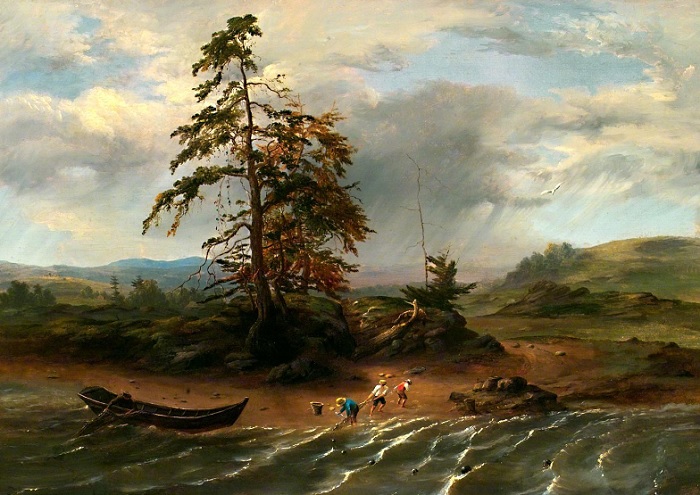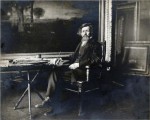
George Inness
American, 1825-1894
Landscape with Fishermen, 1844-1847 ca.
oil on canvas
25 x 36 in.
SBMA, Gift of Mrs. Tracy W. Buckingham
1977.34

Inness seated in his studio with a brush in his hand and his hat in his lap. Inscriptions lower right: "Yours Respectfully, Geo. Inness." Annotation on verso (handwritten): If you have Fifty-Eight Paintings by George Inness*, you may be able to identify painting in easel. *by Eliott Dangerfield, published by F.F. Sherman.
RESEARCH PAPER
While some biographers refer to this oil on canvas landscape painting measuring 25" X 36" as "Untitled", others call it "Landscape with Fishermen". For purposes of this paper, I refer to the painting as "Landscape with Fishermen”. It is signed 1.1: "G. Inness", not dated. We can assume that George Inness painted the landscape in 1844, for when the backing of the painting was removed for re-lining, a note from James Inness, brother of George, was attached to the back of the painting. In this note James Inness stated, "The group of trees and rocks in the foreground were taken from the Sharp Mountains in the Borough of Pottsville, Pennsylvania, AD l844". The painting was apparently presented to James Inness as a wedding gift in l847. The destiny of the painting is unknown between the time James Inness owned it, and when it came into the possession of Mrs. Tracy Buckingham (now deceased). It is known, however, that Mrs. Buckingham donated the painting to the Santa Barbara Museum of Art (SBMA) on December 14, 1977.
In viewing this action painting "Landscape with Fishermen", one can see three men standing on the shore pulling in a fishing net. Another figure can be seen in a small boat, also pulling in the net. A dark cloud appears behind two large trees, which trees seem to be bending in the wind, which could indicate that a storm is brewing. A storm was always one of Inness’ favorite subjects. There is a lone seagull apparently getting ready to swoop down on the water. The white caps appear to be flowing in one direction from the wind; whereas the large trees appear to be bending in another. The wind seemingly blowing in two different directions is perhaps an incident where Inness took the liberty of his own interpretation or "imitation" of nature. He did take great liberty in changing nature in his paintings. For example, in "Landscape with Fishermen" it is known that there was no body of water near the Sharp Mountains in Pennsylvania, where we can assume the work was executed (as noted in the previous paragraph). Yet, part of the painting did apparently come from nature. Also, Inness was devoted to color as is evidenced by the variety of colors used for the land, figures, sea and sky. This early part of Inness’ career belongs to the period o: naturalism and luminism.
George Inness was born May 1, l825, near Newburgh, New York. He was the son of a prosperous merchant of Scotch decent, who made his fortune early in life and retired on a farm, the birthplace of his son George. George was the fifth of thirteen children. It is interesting to note that all of his brothers grew up to become prosperous businessmen; whereas, George never wanted to be in business. Instead, he was a dreamer and wanted to be a painter from his earliest childhood.
The family moved to New York when George was only a few months old, and they moved again to Newark, New Jersey, where George spent his boyhood. In Newark he attended the academy, but failed in this endeavor. It is said his failure was not due to lack of intelligence but because he was not a healthy boy. Many biographers (including Nicolai Sikorsky, Ir.) believe he was an epileptic, which attacks continued throughout his life. However, George Inness, Jr., his father's biographer and also an artist, never mentioned his father’s illness as being epilepsy. The illness limited his education, but did not keep him from living a normal life.
His father placed George in the art studio of a man named John Jesse Barker (in 1840 or 1841). Barker was a teacher of drawing and painting in Newark. After only a few months of study Barker felt that Inness knew as much as he, in spite of the fact that Barker claimed to have studied with Thomas Sully, revered to be an outstanding artist of the day. It is possible that Barker was responsible for Inness’ richness of brush and pigment, a style similar to that of the Hudson River School painters (which I shall discuss later) found to be conventional and superficial.
Inness always claimed to have been self-taught. It is felt that the most important influence on Inness’ artistic career was his brief study with French-born painter Regis Francois Gignoux, It is believed that it is not what Gignoux taught Inness, but rather what he represented. Gignoux received training from great European and contemporary French painters, which knowledge he passed on to Inness. In particular, Gignoux was a pupil of Paul Delaroche, who was a landscape painter influenced by 17th century Dutch landscape art. He was later a pupil oi Baron Gros who, in turn, was a pupil of Jacques Louis David. This impressive background made Gignoux a direct heir to the greatest landscape paintings in all Europe. From all of this Inness must have learned something that his contemporaries (the Hudson River School painters) did not. That is, a deep admiration, almost emulation, of old landscape paintings of Old Masters. Inness’ style was similar to Italian and Dutch landscapes such as those of Claude Lorrain, Gasper Poussin and Meindert Hobbema.
About this time, there was a group of American landscape painters of whom Inness was a contemporary, who shared styles and ideals following the methods of Thomas Cole and Asher B. Durand. These artists were America's most admired artists preceding the Civil War. They were closely associated with the Hudson River Valley, especially the Catskill Mountains; and they came to be called the Hudson River School. Although most of these artists associated themselves with the Hudson River Valley, Inness was heading in another direction. Whereas most of these artists depicted nature, Inness wanted to be his own person - use his own imagination. He understood that art and nature were two different entities; and that it is the artist's responsibility interpret nature and not merely copy it.
Inness felt that some attributes he found in the engravings of Old Masters were in the style of Cole and Durand; although Cole and Durand did not want this to be noticed. American landscape artists did not accept the style of those Old Masters, as did Inness. Durand once stated, "artists should first study nature, and when they have learned to imitate it they could then study the Old Masters". Inness painted for approximately a decade, pictures that defied artistic principles and practices. His first aim was to give American romantic realism a painterly breadth of touch and richness of impasto. He wished to break away from the linear touch of Duran and Cole. As a matter of fact, when Inness tried to catch the Hudson River School's elaboration of detail, he found that he lost the sense of space and distance along with his subjective feeling for nature’s mysteries. He modified Giignoux’s methods. Inness believed that the true purpose of a painter was to reproduce in other minds the impression which the scene made on the painter.
It has been said that the work of George Inness has been divided into three periods. This work, "Landscape with Fishermen", belongs to the first period, as it was one of his first, if not THE first paintings. This period shows Inness as a conscientious and analytical student of nature, following the Old Masters. Here, placement, pattern, rhythm, order and variation are carefully plotted. Brush work is evident in its variety. Naturalism and luminism are also evident. To reiterate, Inness understood that art and nature were two different things. He felt that it was the artist's function to interpret nature and not just copy it.
During 1853 (the beginning of his second period), Inness went to Europe where he spent about a year, primarily in France. (He made several other trips to Europe during his lifetime). Here he discovered French landscape painting of the Barbizon School. The name "Barbizon" came about from the fact that most of its artists worked in and around the village of Barbizon in the Fontainebleau Forest near Paris. This visit to Europe was apparently the most decisively important experience of his artistic life. He completely re-made the appearance of his art under Barbizon influence. He replaced dark tones and the following of the Old Masters’ paintings with more informal pictorial construction - lighter and fresher color and simpler compositions. All of the paintings made after this trip would in some way show the influence of the Barbizon artists such as Rousseau (thought to have been the most influential), Dupre, Diaz, Troyon, Corot and others. It should be stated that even though his paintings reflected the Barbizon influence, Inness could never be considered a copyist - he always made his own interpretations in his artistic endeavors.
In this third and last period (roughly the last ten years of his life), Inness’ style became more and more synthetic. During this period, he painted his most beautiful works, according to his critics. These critics claimed, relating to this period, that Inness was America's - even the world's greatest landscape painter. It is said further that "George Inness was a pathfinder where originality and firey zeal for nature blazed a new trail that has led to the present impressive expansion of American landscape painters". He was one of the founders of modern American painting. His works with each passing year continue to grow in stature, as leading museums and collectors as well vie for his superb landscapes.
Prepared for the Santa Barbara Museum of Art Docent Council by Lois Shaw, April 1, 1987
BIBLIOGRAPHY
Books:
Caffin, Charles H. The Story of American Painting: The Evolution of Painting in America from Co1onial Times to the Present. New York. Frederick A. Stokes Company Publishers, 1907.
Flexner, James Thomas. That Wilder Image. New York, Bonanza Books, 1952.
Inness, George Jr. Life, Art, and Letters of George Inness. New York, Kennedy Galleries and DaCapo Press, a division of Plenum Publishing Company, 1917.
Ireland, LeRoy. The Works of George Inness. Austin - London, University of Texas Press, 1965. (Published in cooperation with the University Art Museum of the University of Texas.)
Isham, Samuel. The History of American Painting. New York, the MacMillan Company, 1927.
Richardson, E.P. Painting in America from 1502 to the Present. New York, Thomas Y. Crowell Company, 1956.
Werner, Alfred. Inness Landscapes. New York, Watson-Guptill Publications, 1973.
Exhibition Catalogues:
Los Angeles County Museum of Art, "George Inness". Exhibition was organized by the Los Angeles County Museum of Art, and held at the Metropolitan Museum of Art, New York, April 1 - June 9, 1985, and at other museums.
Santa Barbara Museum of Art, "The Preston Morton Collection of American Art," 1981.
University Art Museum of the University of Texas, The Paintings of George Inness (1844 – 94); Dec. 12, 1965 – Jan. 30, 1966.
Periodical Articles:
Cikovsky, Nicolai Jr., “George Inness and the Civilized Landscape”, USA Today, vol. 155 no. 2494, July, 1986, pp. 62-91.
